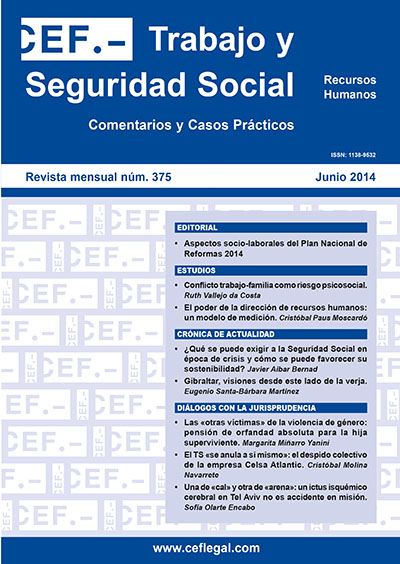Power in the firm: an approach to its measurement. A field study: the power of the human resources direction in the Valencian Community
DOI:
https://doi.org/10.51302/rtss.2014.2946Keywords:
power index, human resources, sources of power in a firmAbstract
On a representative sample of 111 executives, this research designs an assessment and measurement tool of the concept of «management power» within the company. In a firm, it can be distinguished a power that relies on the formal position, shown by the organization chart, and a power that relies on the person, as an individual. Both of them thrive in the cultural and organizational frame of the company, and both of them intend to get their maximum potential; the final results and the alignment of these results with the business objectives will give us the level of reached power. Therefore, our model considers the sources or decisive elements of power, the factors which contribute or limit it, and the consequences of its practice. This so called «power index model» consists in a scoring (in a 1.000 points scale) as a result of adding up 16 weighted indicators, gathered in 6 subfactors, and these in 3 key factors, according the following formula: power index = resources + limitations + results. The weight of each factor comes from the weighting given by an experts panel, and it is as follows: resources (27 %), limitations (35 %), results (38 %).
Downloads
References
Blalock Jr., H. M. [1989]: Power and conflict. Toward a general theory, Newbury Park: Sage Publications.
Blanchard, K. et al. [2007]: Liderazgo al más alto nivel, Bogotá: Norma.
Boulding, K. E. [1993]: Las tres caras del poder, Barcelona: Paidós.
Burt, R. S. [2005]: Brokerage and closure: An introduction to Social Capital, Oxford: Oxford University Press.
Duso, G. (coord.) [2005]: El poder. Para una historia de la filosofía política moderna, México: Siglo XXI.
Galbraith, J. K. [1984]: La anatomía del poder, Madrid: Plaza y Janés.
Goleman, D. [2000]: «Leadership that get results», Harvard Business Review, marzo-abril, págs. 79-90.
Granovetter, M. S. [1995]: Getting a job: a study of contacts and careers, Chicago: University of Chicago Press.
Hersey, P.; Blanchard, K. y Johnson, D. E. [1996]: Management of organizational behavior, Upper Saddle River: Prentice Hall.
Hofstede, G. [1980]: «Motivation, leadership and organizations: Do american theories apply abroad?», Organizational Dynamics, summer, págs. 42-63.
Kaufmann, A. E. [1993]: El poder de las organizaciones, Madrid: ESIC.
Keltner, D. y Gruenfeld, D. H. [2003]: «Power, approach, and inhibition», Psychological Review, vol. 110, núm. 2, págs. 265-284.
Kotter, J. P. [1982]: El poder gerencial. Cómo reconocerlo, obtenerlo y usarlo, México: Interamericana.
Lawrence, P. y Lorsch, J. W. [1987]: La empresa y su entorno, Barcelona: Plaza y Janés.
Lucas, A. y García, P. [2002]: Sociología de las organizaciones, Madrid: McGraw-Hill.
Lukes, S. [2007]: El poder. Un enfoque radical, Madrid: Siglo XXI.
Mann, M. [1991]: Las fuentes del poder social, I. Una historia del poder desde los comienzos hasta 1760 d.C., Madrid: Alianza, vol. I.
McClelland, D. [1966]: Leadership and motivation, M.I.T. Press.
McClelland, D. y Burnham, D. H. [2003]: «Power is the great motivator», Harvard Business Review, 81, enero, págs. 117-126.
McGregor, D. y Bennis, W. [1994]: El lado humano de las organizaciones, Bogotá: McGraw-Hill.
Menéndez Alzamora, M. (ed.). [2007]: Sobre el poder, Madrid: Tecnos.
Mintzberg, H. [1988]: La estructuración de las organizaciones, Barcelona: Ariel.
— [2004]: Pouvoir et government d'enterprise, París: Editions d'Organisation.
Morriss, P. [2002]: Power: A philosophical analysis, Manchester: University Press.
Ouchi, W. [2009]: La teoría Z, Buenos Aires: El Cid.
Perrow, C. N. [1991]: Sociología de las organizaciones, Madrid: McGraw-Hill.
Pettigrew, A. M. [1972]: «Information control as a power resource», Sociology, núm. 6, págs. 187-204.
Pfeffer, J. [1978]: «The micropolitics of organizations», Enviroment and Organizations, eds. Marshall W. Meyer and associates, San Francisco: Jossey Bass.
— [1978]: Organizational design, Arlington Heights: Harlan Davidson.
— [1981]: Power in organizations, Marshfield: Pitman.
— [1992]: Managing with power. Politics and influence in organizations, Boston: Harvard Business School Press.
— [2010]: Power. Why some people have it- and others don't, Nueva York: Harper Collins.
Ricart, J. E.: «Asignación de derechos de decisión», en Ricart, J. E.; Gallo, M. A. y Fraguas, R., Diseño de organizaciones, Barcelona: Folio, 1997, págs. 17-47.
Robbins, S. P. [2001]: Comportamiento organizacional, Madrid: Prentice-Hall.
Russell, B. [1949]: Autoridad e Individuo, México: Fondo de Cultura Económica.
— [2011]: El poder. Un nuevo análisis social, Barcelona: RBA.
Scott, J. (ed.) [1994]: Power: critical concepts, 3 vols., Routledge: Londres.
Seperich, G. J. y McCalley, R. W. [2006]: Managing Power and People, Nueva York: M. E. Sharpe.
Tiedens, L. Z.; Unzueta, M. M., y Young, M. J. [2007]: «An unconscious desire for hierarchy? The motivated perception of dominance complementarity in task partners», Journal of Personality and Social Psychology, vol. 93, núm. 3, págs. 402-214.
Trompenaars, F. y Woolliams, P. [2004]: Business across cultures, Chichester: Capstone.
Wildavsky, A. [1984]: The politics of the budgeting process, Boston: Little Brown.
Wolf, H.-G. y Moser, K. [2009]: «Effects of networking on career success: a longitudinal study», Journal of Applied Psichology, 94, págs. 196-206.
Wrong, D. H. [1979]: Power: Its forms, Bases and Uses, Oxford: Basil Blackwell.
Zaleznik, A. y Kets de Vries, M. F. R. [1975]: Power and the corporate mind, Boston: Houghton Mifflin.


















